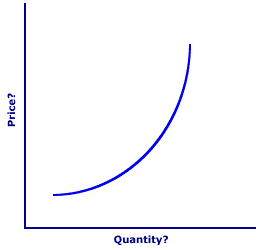
|
|
YIELD: The rate of return on a financial asset. In some simple cases, the yield on a financial asset, like commercial paper, corporate bond, or government security, is the asset's interest rate. However, as a more general rule, the yield includes both the interest earned from an asset plus any changes in the asset's price. Suppose, for example, that a $100,000 bond has a 10 percent interest rate, such that the holder receives $10,000 interest per year. If the price of the bond increases over the course of the year from $100,000 to $105,000, then the bond's yield is greater than 10 percent. It includes the $10,000 interest plus the $5,000 bump in the price, giving a yield of 15 percent. Because bonds and similar financial assets often have fixed interest payments, their prices and subsequently yields move up and down as economic conditions change.
Visit the GLOSS*arama
|
|


|

|
                           SHORT-RUN AGGREGATE SUPPLY AND MARKET SUPPLY: The short-run aggregate supply curve, or SRAS curve, has similarities to, but differences from, the standard market supply curve. Both are positively sloped. Both relate price and quantity. However, the market supply curve is positively sloped due to the law of diminishing marginal returns and the short-run aggregate supply curve is positively-sloped due to inflexible prices, the pool of natural unemployment, and imbalances in real resource prices. | Two Similar Curves |  |
To illustrate the specific short-run aggregate supply and market supply curve similarities and differences consider the graph of a positively sloped curve displayed here. Is this a market supply curve or an short-run aggregate supply curve? A cursory analysis suggests that it could be either.To reveal the similarities between the both curves, click the [Market Supply] and [Aggregate Supply] buttons. Doing so illustrates that both curves are positively sloped, with each virtually overlaying the other. Consider the differences between these two curves. - First, note that for the market supply curve, the vertical axis measures supply price and the horizontal axis measures quantity supplied. For the short-run aggregate supply curve, however, the vertical axis measures the price level (GDP price deflator) and the horizontal axis measures real production (real GDP).
- Second, the positive slope of the market curve reflects the law of supply and is attributable to the law of diminishing marginal returns. In contrast, the positive slope of the short-run aggregate supply curve is attributable to: (1) inflexible resource prices that often makes it easier to reduce aggregate real production and resource employment when the price level falls, (2) the pool of natural unemployment, consisting of frictional and structural unemployment, that can be used temporarily to increase aggregate real production when the price level rises, and (3) imbalances in the purchasing power of resource prices that can temporarily entice resource owners to produce more or less aggregate real production than they would at full employment. Similar, but different.
Most notable, the differences between market supply and short-run aggregate supply means that it is not possible to merely add up, or aggregate, the market supply curves for the thousands of goods produced in the economy to derive the short-run aggregate supply curve. The short-run aggregate supply curve dances to its own music and plays be its own set of rules.

Recommended Citation:SHORT-RUN AGGREGATE SUPPLY AND MARKET SUPPLY, AmosWEB Encyclonomic WEB*pedia, http://www.AmosWEB.com, AmosWEB LLC, 2000-2024. [Accessed: October 21, 2024].
Check Out These Related Terms... | | | | | |
Or For A Little Background... | | | | | | | | | | |
And For Further Study... | | | | | | | | | | |
Search Again?
Back to the WEB*pedia
|



|

|
BEIGE MUNDORTLE
[What's This?]
Today, you are likely to spend a great deal of time watching infomercials looking to buy either a desktop calendar with all federal and state holidays highlighted or a half-dozen helium filled balloons. Be on the lookout for a thesaurus filled with typos.
Your Complete Scope
This isn't me! What am I?
|

|
|
Two and a half gallons of oil are needed to produce one automobile tire.
|

|
|
"A stumble may prevent a fall. " -- Margaret Thatcher, British prime minister
|

|
TSE
Toronto Stock Exchange
|

|
|
Tell us what you think about AmosWEB. Like what you see? Have suggestions for improvements? Let us know. Click the User Feedback link.
User Feedback
|


|


